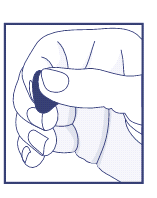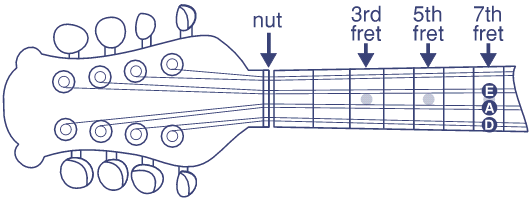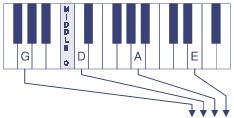|
|
|
Mandolin Tutorials
2) Tuning
|
|
The Plectrum
 There are lots of different opinions about the plectrum, also called the pick. Some books will advise you to use a soft pick; others will recommend a stiffer one. I'm afraid in the end it comes down to personal preference as to which pick will suit you. I would say start with a medium pick and see how it suits you. Try a thicker one and a thinner one after a while and see what difference there is. There are lots of different opinions about the plectrum, also called the pick. Some books will advise you to use a soft pick; others will recommend a stiffer one. I'm afraid in the end it comes down to personal preference as to which pick will suit you. I would say start with a medium pick and see how it suits you. Try a thicker one and a thinner one after a while and see what difference there is.
Many players say that tortoiseshell picks are the best, but in order to protect the world turtle population, it is best to avoid them. There are plastic imitation and synthetic tortoiseshell picks which are not bad at all (my favourite pick is one of these).
Hold the pick firmly between the thumb and the index finger. The other fingers should be roughly in line. The thumb should be more or less straight with the pointed end of the plectrum coming out at almost right angles.
Many players, even professionals, like to play with the round end the the pick instead of the pointed end. Again, this is simply down to personal preference. I would recommend starting with the pointed end, and after while, turn it round and see if any advantage can be gained.
It is important that the pick is held loosely. If you are dropping the pick, then it is too loose, otherwise loose is good. As you become more experienced, you will adjust to holding it with just enough tension without impairing your stroke.
Tuning
First Advice: Don't Panic!
Tuning is one of the first major challenges you'll face as a mandolin player; even professionals have difficulties from time to time, so don't get discouraged. There really is no common approach. In fact I'll describe several methods, and you may choose one which suits you best.
 Electric Tuner
Electric Tuner
One of the advantages of an electric tuner is that if you have difficulty with pitch, you may trust technology to help. It can keep the mandolin tuned within the range it was meant to be played (E-A-D-G). Tuning higher than that risks damage to your instrument. The cheaper electronic tuners may be a little tricky to use, resulting in frustration, but it might beat the frustration of feeling unable to tune at all.
Tuning Fork
Buy an "A" tuning fork; this coresponds with the second string on the mandolin (Note: the highest string, the "E", is called the first string, the second highest, the A is called the second, and so on). Hold the tuning fork between thumb and forefinger and knock it against your knee. Then place the base of the fork on the bridge and listen to the note. Keep it in mind and tune the A string to the note. Strike the tuning fork again and compare the note with your string. It's best to tune up rather than down, so if your string is sharp (that is, a higher note than the one you want), tune it down first and then up to the right note.
The A string is almost always the first string tuned. Tune one of the strings first, and then its pair to match. Once the A strings are tuned, you're going to use them to tune the rest of the strings.

The next string is the third string, or "D" string.Place your finger on the D string at the seventh fret. This should produce the same note as the open A string. If it sounds sharp, adjust the peg down and try again. Tune one of the pair of strings at a time. Once the D string is at the same pitch as the A, match its pair.
The next string to tune is the first string (also known as the "top" string, or the "E" string, and the same method is used. Place your finger on the A string at the seventh fret. This should produce the same note as the open E string. If it doesn't, adjust the peg for the E string (NOT the A string) until the E is in tune. Now match the other E string to the one you've tuned.
Finally go to the G string (also called the fourth or bottom string). Place your finger on the G string at the seventh fret. This should produce the same note as the open D string. If it sounds sharp, adjust the peg down and try again. Tune one of the pair of strings at a time. Once the G string is at the same pitch as the A, match its pair. You'll probably now have to check all the strings again and make smaller adjustments.
|
|
|
|
|
Keyboard
On the right are the four notes on the keyboard which correspond to the mandolin. If you're using an electronic keyboard, avoid vibrato sounds. One thought: if you're tuning to your piano, are you sure your piano's in tune?
|

|

|
 Pitch Pipes
Because the mandolin is in the same tuning as the fiddle, pitch pipes for the violin (pictured left) are a good way of getting the right notes. Blow steadily and even through the pipe with an even strength and adjust the strings accordingly.
Pitch Pipes
Because the mandolin is in the same tuning as the fiddle, pitch pipes for the violin (pictured left) are a good way of getting the right notes. Blow steadily and even through the pipe with an even strength and adjust the strings accordingly.
|
And Finally...
There may be other, more serious reasons for your instrument being out of tune.
- Improper bridge alignment can lead to tuning problems and problems
with intonation. This is easily sorted
(see Maintenance Section).
- Worn frets can cause intonation problems even if your mandolin is
perfectly in tune.
- Old strings are difficult to keep in tune. Some people advise
changing strings once a month, but I think that's a little excessive!
But strings begin to sound dull after a while, and the longer you
leave it, the worse they can sound.
- Warped neck. If this is the problem, it will take a professional
repairer to fix it.
If you find tuning difficult at first, believe me when I say that it gets better the more you practice. By all means use an electronic tuner if it works for you, but keep in mind that one day you may prefer to use another method.
|